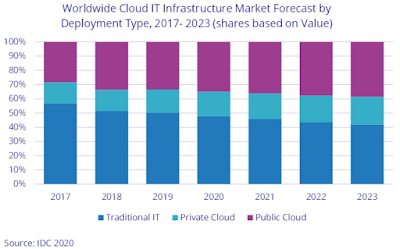
CIOs and CTOs are exploring new ways to extract insights from their enterprise data assets with analytics tools. While they continue to invest in on-premises solutions, they're also looking to public cloud service providers.
As cloud computing providers grow their footprint in the Internet of Things (IoT) value chain, their investments in data and analytics services are accelerating.
Based on the review of cloud service provider offerings, recent acquisitions, and the competitive outlook, ABI Research now forecasts that cloud suppliers will grow their share of IoT data and analytics management revenues from $6 billion in 2019 to $56 billion in 2026.
IoT data and analytics market development
While the growth is impressive, cloud vendor services today are focused on data management complemented by a generic analytics toolset. That said, cloud computing vendor revenues come primarily from streaming, storage, and the orchestration of data.
In contrast, most analytics service offerings across cloud vendors are less differentiated, as reflected in pre-built templates — such as AWS Sagemaker and Microsoft Azure Notebooks — which leverage the Project Jupyter open-source software, standards and services initiative.
Considering that many cloud vendors are in the early stages of their analytics investment, they are relying on their specialized channel partners for addressing more specific 'advanced analytics' and vertical market needs.
"The overall approach shown by cloud suppliers in their analytics services reflects the dilemma they face in the complex IoT partnership ecosystem," says Kateryna Dubrova, analyst at ABI Research. "Effectively, do they rely on partners for analytics services, or do they build analytics services that compete with them?"
Interestingly, streaming is the one analytics technology that all cloud vendors are building into their solution portfolios to blend data management with near-real-time analytics on streamed IoT data.
Companies such as AWS, Microsoft, Google, IBM, and Oracle, for example, are promoting their proprietary streaming solutions to differentiate, accelerate time-to-market, and win over customers.
According to the ABI assessment, companies including Cloudera, Teradata, and C3.ai are introducing streaming analytics services that are reliant upon open-source technology, such as Spark and Flink.
However, by choosing to focus on data management and streaming technologies, cloud vendors are ceding the advanced analytics market to other suppliers. That emerging market is an example of the 'coopetition' in the IoT ecosystem, where cloud vendors partner with advanced analytics experts.
This vendor coopetition enables them to promote an end-to-end IoT technology stack. For example, Azure and AWS have partnered with Seeq to leverage its advance analytics capabilities. Other vendors, such as Oracle, Cisco, and Huawei, are pushing intelligence and analytics closer to the devices, expanding their edge computing portfolio.
Outlook for cloud-based analytics applications growth
Such divergent analytics strategies represent the reality and challenges for serving a very diverse IoT ecosystem with IoT analytics services.
"Ultimately, businesses are moving to an analytics-driven business model which will require both infrastructure and services for continuous intelligence. Cloud vendor strategies need to align with this reality to take advantage of analytics value and revenues that will transition to predictive and prescriptive solutions," Dubrova concludes.
There is a significant upside opportunity for vendors that are exploring the numerous applications for IoT analytics services. Solutions will include both on-premises IT infrastructure and cloud offerings.
 Interested in hearing industry leaders discuss subjects like this and sharing their experiences and use-cases? Attend the Cyber Security & Cloud Expo World Series with upcoming events in Silicon Valley, London and Amsterdam to learn more.
Interested in hearing industry leaders discuss subjects like this and sharing their experiences and use-cases? Attend the Cyber Security & Cloud Expo World Series with upcoming events in Silicon Valley, London and Amsterdam to learn more.







 Interested in hearing more in person? Find out more at the
Interested in hearing more in person? Find out more at the 


